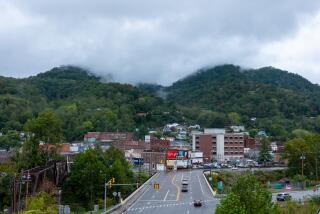Image Change May Be Taking Hold in Appalachia : Hillbillies: A Stereotype That Won’t Die
- Share via
ROANOKE, Va. — Appalachian souvenir shops that peddle T-shirts and coffee mugs with hillbillies on them show that stereotypes of mountain people remain more widely accepted than other minority stereotypes, scholars say.
“You see the little tourist trap places, like hillbilly villages,” said Jean Speer, director of Virginia Tech’s Appalachian Studies Program. “Some of these T-shirts that have hillbilly stereotypes--you couldn’t do that anymore with blacks or Hispanic groups. You couldn’t and you shouldn’t.”
Roddy Moore, director of Ferrum College’s Blue Ridge Institute, said the persistence of the stereotypes has puzzled Appalachian scholars.
“I don’t know why there’s been no outcry from white mountaineers,” he said.
Image of Lazy, Dumb
Speer said the image of mountain people as incestuous, lazy and dumb has become so ingrained into the mainstream culture that social programs sent into Appalachia often are handled by workers who wrongly approach the people.
The myths have been perpetuated through such entertainment as television’s “Beverly Hillbillies” and “The Dukes of Hazzard,” through “Li’l Abner” and “Snuffy Smith” on newspaper comics pages, and in the news media.
“The effect sometimes is it makes the people it represents silly, like they don’t count,” Speer said.
Vaughan Webb, a folklorist at Ferrum College, said the stereotypical image of mountain people was born in the early part of the century, when missionaries came into Appalachia to set up schools for mountain people and to look for ways to change their way of life.
“Many of them also were looking for ways for mountain people to make money and get out of what many people perceived as the poverty of a self-sufficient life style,” Webb said.
Part of Marketing Strategy
The mission schools put the mountain people to work making crafts that could be sold, and an image of poverty was part of the marketing strategy, he said. “There was a need, not necessarily to exaggerate a sense of poverty, but you did not want to hide it,” he said.
Pictures of barefoot mountain people, for example, were used to stir sympathy among buyers, and the same marketing persists today in tourist traps.
Webb also pointed a finger at the news media.
“There are still photographers working in the mountains today, and I’m not going to name any names, but they alter the image to fit the scene and sell the pictures to national magazines,” he said. For example, he said, the photographers might tell a subject to take his or her shoes off while posing in front of a spinning wheel.
Webb recalled a few years ago when a television producer came to southwestern Virginia and asked a Blue Ridge Institute official for help with a segment on hillbillies, but he could find nothing around Franklin County but red-brick houses. The producer made no show, Webb said.
‘Barefoot With a Gun’
“That person came down looking for someone barefoot with a gun in their hand,” he said.
Speer recalled one of her students who was ridiculed for her mountain accent by city-reared students--that despite the fact that she was a premed biochemistry major who made straight A’s and was Phi Beta Kappa.
The sad part about hillbilly stereotypes, Speer said, is that many mountain people have grown up believing some of them. It causes some to be ashamed of their background when they go to college or move to a city.
“In past years, you would find a lot of people from the mountains who devalue their heritage,” Speer said. “You would sometimes have people not admitting where they were from and saying they were from a nearby city.”
More to Read
Sign up for Essential California
The most important California stories and recommendations in your inbox every morning.
You may occasionally receive promotional content from the Los Angeles Times.













